The Best Party Trick Ever: How to Make Thirty Minute Mozzarella
The following is a guest post from Andrew Wilder of Eating Rules. Welcome, Andrew!
A couple of years ago at a Fourth of July party, I pulled off one of my best party tricks ever.
Showing up with a gallon of milk in hand, I asked my friends if I could borrow their kitchen. Spying the other items in my bag — a bunch of fresh basil and cherry tomatoes — they knew I had something good in store. They eagerly let me take over.
Half an hour later, I emerged victorious from the kitchen with a platter of fresh caprese, made with still-warm mozzarella.
I’ve been using this “30-minute Mozzarella” recipe, from Ricki Carroll’s book, Home Cheese Making, for a few years now. I’ll admit, it comes out slightly different each time (the type of milk, how quickly you heat it, and how much you stretch it will affect both the flavor and texture), but it’s always been a big hit.
Homemade Mozzarella Tips & Tricks
1. This is a great recipe to make with kids. They’ll be completely mesmerized watching the milk curdle and turn into cheese — and it happens quickly enough to hold their attention. The last few steps can get pretty hot, so please do be careful when making this with children.
2. Do not use “Ultra-Pasteurized” milk for this recipe — it won’t curdle properly. If it says just “Pasteurized” on the container, you’re probably fine. Of course, you can also use raw milk instead, if that’s your thing (I’m not going to get into the pros and cons of raw vs. pasteurized milk — just remember that Ultra-Pasteurized is a dealbreaker.)
3. Depending on the fat percentage of your milk, you’ll get a very different cheese at the end. Whole milk produces a very rich, soft mozzarella, whereas 1% will make a harder, more string-cheese-like cheese. Fat free can get a bit too rubbery, so I don’t recommend it. I usually use 2%, which is what’s shown in the pictures here.
I’ve also made this recipe with goat’s milk, and it should work fine with sheep’s milk as well.
4. This recipe is a “shortcut” to mozzarella, since it uses a microwave to speed things along. If you don’t have a microwave, you can use a pot of very hot water and float a bowl in it instead. The goal is to get the curds hot so that they melt together and become stretchy like taffy. Also, the curds will get quite hot — it’s really helpful to have a pair of clean kitchen gloves to protect your hands.
Thanks go to my friend Sarah, who eagerly offered to model for the photos in exchange for some fresh mozzarella.
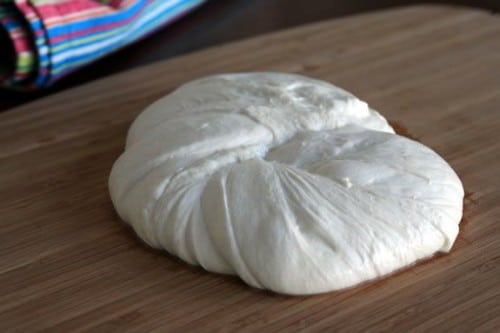
Recipe: Thirty Minute Mozzarella
You can probably find citric acid at a good grocery store, but rennet is harder to come by. You can order it online at several retailers; I’ve purchased it from New England Cheesemaking Supply and Grape and Granary.
You can also just get one of Ricki’s Mozzarella and Ricotta Cheese Making Kit, which have everything you need, including a dairy thermometer.
I prefer to use liquid vegetarian rennet, which New England Cheesemaking Supply sells at double-strength, so I use 1/8 tsp. for this recipe.
Ingredients
- 1 gallon Milk, not ultra-pasteurized
- 1 1/2 tsp. Citric Acid powder, dissolved in 1/4 cup room-temperature water
- 1/4 tsp. Liquid Rennet or 1/2 tablet Rennet, dissolved in 1/4 cup room-temperature water
- 1 tsp. Cheese (Flake) Salt or Kosher Salt
Instructions
1. Pour the milk in to a large pot. On medium-low, heat slowly to 55 degrees Fahrenheit. Stir slowly and continuously to keep from scalding.
2. Once the milk reaches 55 degrees, pour in the citric acid mixture and stir well. Keep heating.
3. When the milk hits 88 degrees, add the rennet mixture and stir well. Right around this time the milk will start to thicken, and you’ll see little white flecks stick to your spoon as it starts curdling.
4. Once the milk is in the 90-degree range, it should be noticeably curdled. Stir very gently at this point, if at all — you want to encourage the curds to knit together.
5. Between 95 and 105 degrees, the curds will be quite thick. Turn off the heat once they start separating from the sides of the pot, and there’s a very clear distinction between the curds (white clumps) and whey (yellow liquid).
6. Let the curds rest for 5 minutes.
7. With a perforated or slotted spoon, ladle the curds into a bowl. The curds will continue expelling whey once they’re in the bowl, which is fine. Once you have pulled most of the curds out of the pot (some little bits will probably still be floating about), pour any excess whey back in the pot.
8. Using a microwave, heat the curds for 60 seconds. Drain off any excess whey, then fold the curds over once, then once again. This is to distribute the heat evenly.
9. Microwave again for about 30-40 seconds, depending on the strength of your microwave. Pour off the whey.
10. Sprinkle the salt onto the cheese, and then fold the curds over twice again. Put them back into the microwave for another 30-40 seconds. Pour of any excess whey.
11. At this point, the cheese should be very hot, and look like melted mozzarella!
12. Stretch the cheese, and then fold it back on itself. If it tears when you try to stretch it, the cheese is not hot enough; just repeat the microwaving process. Stretch it again once or twice. If you want a more string-cheese like cheese, do it a few more times.
13. You can then twist or braid the cheese, or tear off pieces and roll them into small balls. If you’re going to refrigerate the cheese for later, drop it in a bowl of ice water to get the temperature down quickly. Otherwise, just dig in while it’s still warm!
Editor’s note: Don’t toss that whey! You can use it in pancakes or crepes.
What do you say, are you up for a ‘cheesy’ party trick?

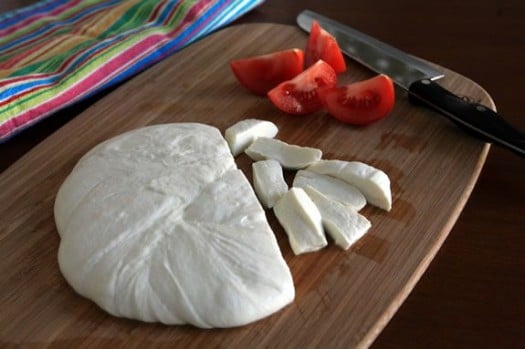
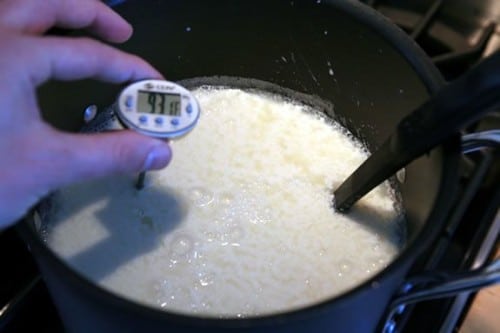
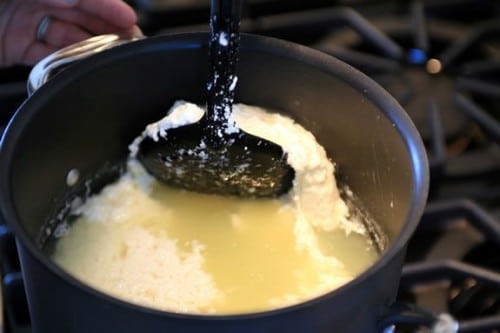
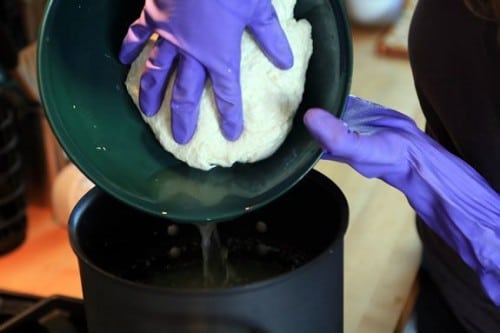
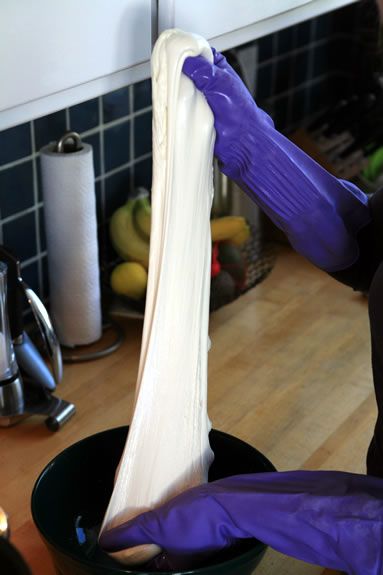
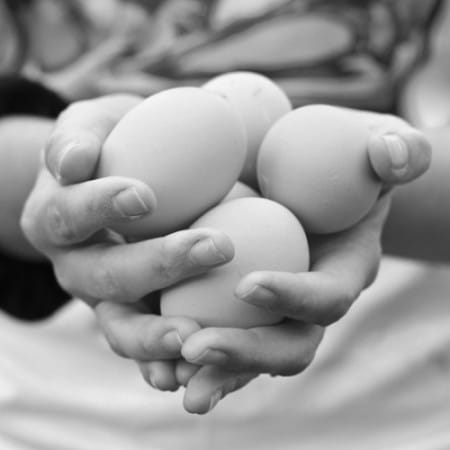
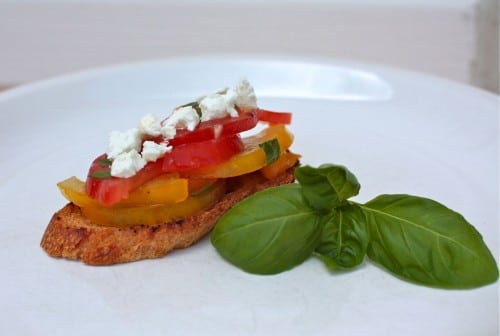
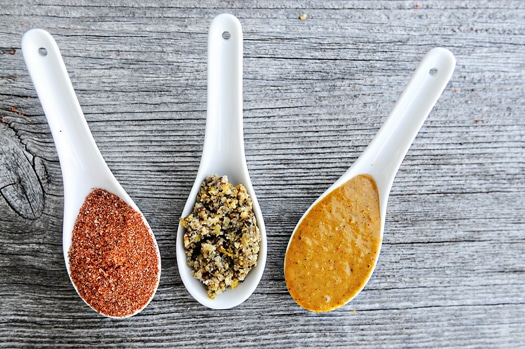
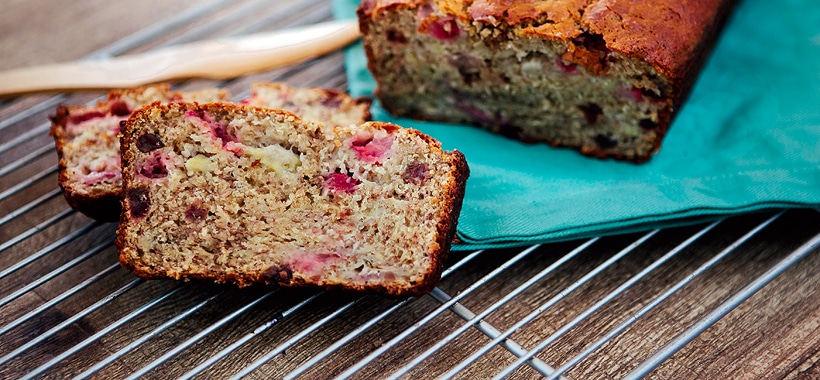
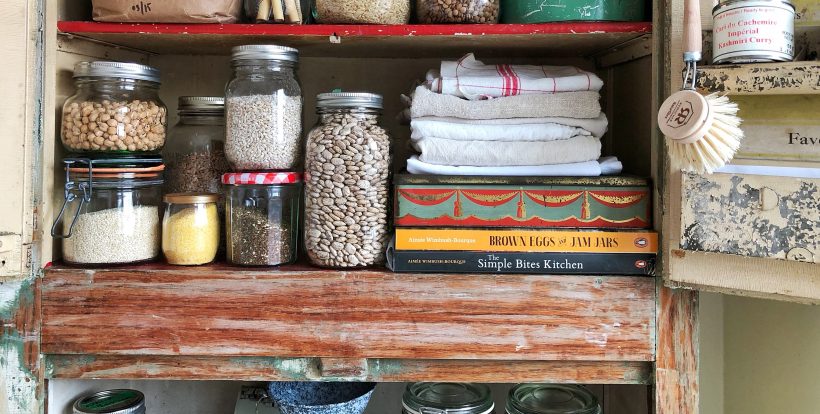

Andrew,
I may be a little slow but did you microwave on full power?
Yep!
Hi,
Sent for one person bilingual:
I am French, could I have the exact translation of the recipe?
Thank you
Elea – did you get the french translation? I could do it for you if it is ok for the people here 🙂
I have tried this recipe many many many times and have never gotten cheese like yours to come out! I found the rennet, I found the citric acid and that was feat in itself but never comes out right! Please help!
Are you sure you’re not using “Ultra-Pasteurized” milk? That won’t work. And have you tried more than one brand of milk? (It’s possible they’re over-heating it, to ultra-pasteurized temps, but just not labeling it as such.).
And if that doesn’t solve it, can you share some details about what is going wrong? Are there curds forming at all?
Most times I just use the Walmart brand 2% milk. After the 5 minute rest period, I have some curdling and some whey but there is still a milky-ness to it. I have tried to go to a higher temperature too. Usually about 115-120 I get more separation but isn’t it too hot by that point?
I haven’t used the Walmart brand, but I wouldn’t be surprised if they over-heat their milk. Definitely worth trying a different brand.
You could also try increasing the quantity of citric acid and rennet. Going to a higher temp probably won’t help… So try more citric acid (maybe 2.5 teaspoons), and hold it at 105 degrees a little longer if need be (until the whey is a little clearer and less milky).
Ok I will try a different brand and more acid next time. Thanks for the help. I will keep you informed on how it goes 🙂
More acid won’t help– any more than Ricki’s recipe calls for, and all of the proteins will be denatured and unavailable to rennet act on. A little more rennet _might_ help, but it’s likely a heavy hand with citric acid or the butterfat content of the milk that’s to blame.
It would be better to use raw milk, I had a coffee shop and when the milk from the store is over pasturized it won’t give that stand up foam for a latte, it is over processed. I found that certain brands were worse than others, you are right they over heat the milk and its easier to find a local farmer or dairy. Good luck.
Try using raw or local milk – Walmart milk, or any milk for that matter, if it will not make cheese is deader than a doornail and should not be consumed.
I just made this yesterday, and while I did make mozzarella, it is kind of tough. Not at all like fresh mozzarella, but the store made kind. What might have I done wrong?
Thanx in advance,
Melissa~
The cheese usually comes out more like a string cheese for me – it’s not super-creamy like a “buffalo” mozz. What was the fat content of the milk? 2% will produce a firmer cheese than whole milk.
No, I used whole pasteurized milk. Yes. Mine was more like string cheese. Was hoping for a creamier consistency. Was wondering if I didn’t microwave for the third time? Oh, well. It was fun to do!
I had same problem milk cuddled but whey was not yellow it was still milky.I added one extra tsp. Of citric acid dissolved in 1/8 cup of h20……immediately it helped!
Kristy, it sounds like a couple of things could be at fault. First, try using whole milk– the curds are made up of proteins that gather fat together, and if there isn\’t enough fat, the proteins won\’t have anything to help them form curds. It could be that your milk is UHT, but I doubt it, as most store-brand milk will be plain-old pasteurized, while many organic milks and products like heavy cream (those things that don\’t sell as quickly) will be ultra-pasteurized. If your whey is cloudy, you might be adding a little too much citric acid, which is going to break apart too many proteins, and not leave anything for the rennet to do. Think about something like ricotta or creme fraiche– if you\’re ending up with that, you\’ve added too much acid. Heating above 90-100 degrees is only going to make it worse– rennet won\’t be able to be active at that point, and you\’re going to end up with a heat-precipitated cheese (like ricotta) that you won\’t be able to stretch. Try reducing the citric acid a smudge, and using whole milk, and see if that helps things.
Well tried again. Got different milk and ended up with curds and whey. (Woohoo) Then nuked it, then again, then again and no melted motz. Ugh Going to try whole milk next time and try again. I am determined this is going to work lol. But the ricotta I ended up making out of this batch was wonderful. 🙂
Well, that’s a step closer, at least! I wonder if you need to let the curds set a little longer before scooping them out of the pot. They should be fairly firm as you’re getting them out. If they’re as thin as ricotta, they’re too thin.
Also, once you hit about 100 or so, lower (or turn off) the heat. Usually by the time you get to 105 they’re pretty firm — but you don’t want to overshoot that temp, as Sascha pointed out.
Kristy, if you’re getting curds but they’re not stretching and you’re willing to wait, try skipping the microwaving step and leaving them to drain in cheese cloth set in a colander over a bowl over night. The microwaving step here is a shortcut meant to simulate a drop in acidity that makes the curds easier to stretch (think about stretching fresh goat cheese– wouldn’t work at all, and that’s because of acidity) but you’ll actually have more luck if you let the curds come to the proper pH by themselves over time. After they’ve drained overnight, leave them in 100 degree water for about 5 minutes, and then stretch them in water that is 140-180 degrees (start at 140, and if they won’t stretch or if they break, increase your temperature gradually until you get a shiny, stretchy curd). You’ll want to leave them in the hot water for a few minutes before you stretch, too, so that the curd is warmed through. Keep at it– I’m sure you’ll have perfect mozzarella, soon, and in the meantime, enjoy that ricotta! 🙂
Fantastic post
I just made this and it’s delish!! I am wondering about the consistency though. It looks just like yours but is almost like cream cheese in the middle. Firmer cause I can slice through it and place on a cracker but I can also squish it on a cracker like cream cheese. On the other hand It melts like a dreamy mozza.
So I am very happy with it but I want to know if it’s supposed to have that creamy texture.
Mine usually comes out more like string cheese (especially when I use 2% instead of whole milk) — and I find the more times I stretch it (stretch, then fold over, then stretch again), the stringier it gets. (Once it cools, it’s really hard not to eat the entire thing within the day…).
Did you let the curds set for the full five minutes, before ladling them out of the bowl? Also, it’s okay if it takes a few minutes to scoop them all out — that gives them a chance to rest in the bowl and continue expelling whey before they go into the microwave (just pour off that extra whey before microwaving — they’ll continue to expel whey during the microwaving process, just keep pouring it off).
Everything was going swimmingly. I had curds. I had whey. I ladled them. They even already sort of were stringy and melty looking. I nuked them. They turned into ricotta. I guess I will have to try something else after the cooking process to get to mozzarella.
Hmm… it almost sounds like your temperature may have been too high as you took them out of the pot, if it was already stringy/melty (unless they were just too soft, but that would probably be more like yogurt). Any idea of the final temp in the pot? And, how long did you microwave them each time?
Hi! I just wondered if the citric acid is completely necessary, or if I could substitute with lemon juice or something else.. thank you!
i just got done using 4 1/2 tbsps of lemon in replacement of the citric acid and it worked fine, not sure if made less because it was my first try. I hope this helps. 🙂
thanx! I’ll try it like that!
I use cider vinegar in my goat milk cheese.. works wonderfully!
Have you able to freeze the cheese?
I’ve never actually tried, since it’ll keep for at least a week or so in the fridge (though it’s always been eaten long before that!). I’m guessing it’ll change the texture — but not exactly sure. If you try it, please report back!
I am so happy to have come across this recipe . My problem is : no rennet and no citric acid available here. But plenty of limes. Is the temperature In Celsius ? And I don’t have food thermometer , not sold here. My mum used to use her finger to measure. Usually the milk for yoghurt and white cheese needed to be just tolerable to the body , about 38-39C. Is the same for the mozzarella ?
Thanks
I used to won a pizza place, and many cheese suppliers keep the shredded mozzarella frozen, and then it is thawed in a refrigerator for a few days to temper it. It seems to work fine, but I have tried this with sliced cheddar, and it just crumbles when you try to peel off a slice.
Generally speaking, you can’t freeze cheese as it will become very crumbly. It’s still okay for cooking though.
Hi! i was wondering what kind of thermometer you were using in the above pics? I’m planning on trying this recipe but want to make sure I have all the tools that I need. Thanks! 🙂
I like using a digital thermometer, because it gives a fast, accurate read. But you can use any thermometer that will read accurately between 50 and 200 degrees F. (A candy thermometer isn’t a good choice, it’s designed for much higher temps). I use a CDN thermometer — I think this is a similar model http://amzn.to/Pjcldy
Do grocery stores carry the Citric Acid and Liquid Rennet ? If not, where is the best place to locate these ingredients? I appreciate your help…I really am looking forward to trying this sometime this week.
You can probably find the Citric Acid at a decent grocery story. It may be in the spice aisle, or the “ethnic foods” aisle (try near the Indian foods). Rennet is harder to come by, and probably won’t be at a regular grocery store. I buy mine from New England Cheesemaking Supply, http://www.cheesemaking.com. Have fun!
I found rennet at my local Quality Foods grocery store in the ice cream section. I had looked everywhere for it and ran into it while buying icecream, who would’ve thunk it. The citric acid I found in the canning section, like where they sell all the supplies to can fresh veggies and such.
Nice!
You can do the same with 3/4 cup of vinegar instead of the rennet and citric powder
So, can’t you just come to my house and show me what I am doing wrong?!?! Better yet, just come over and make it for me?!?!?! (BIG SMILE)
How clean are your surfaces, pots, and utensils? Before I start, I rinse everything that touches my milk or cheese first in tap water and then in distilled water, and I always use distilled water for dissolving rennet, acid, and lipase. If you use a municipal water source, the water contains chlorine and this will prevent rennet from forming complete curds.
For Mozzarella, or any cheeses that are going to be fresh (not aged), I just make sure to wash, rinse, and dry everything by hand before I start. For anything that’s going to be aged, like a cheddar, I’ll sanitize everything (and wipe down countertops) with Star-San before I begin.
I usually use filtered water for the rennet & citric acid. though I’ve never had a problem with using regular (unfiltered) tap water. Of course, every municipal water supply is different, so your mileage may vary…
Just made this cheese! Turned out fabulous!! No luck with braiding it, that’s my own lack of skill though :). I used whole milk, and it came out super creamy and delicious. Quite a bit of salt for a fresh mozza, but I love salty so no problem there for me, just a heads up. I found, not having kitchen gloves on hand, that using a spoon to fold over the heated curds worked, and I had to do this repeatedly to achieve the creamy mozza texture. At first it still seemed grainy and curdy, but after multiple folds, voila! perfection.
Used your recipe after failing with another. End result: perfect soft, creamy, delicious mozzarella. It’s currently melting onto dinner. Heavenly.
YEAH!!! I finally did it!! After months of trying to make cheese and yogurt from my goats milk I finally discovered what I was doing so wrong..I was using a thermometre in celcius!! So I gave it another try and , OMG!! I have a ball of mozarella from my fresh goat milk, WOOHOO! It’s a tiny bit rubbery but for my first time I’m thrilled…so what did I do that made it rubbery,lol? BTW, your info here has made all the difference. Thank you so very much, now I’ll be making cheese as fast as my goat can produce milk!
I just have to say… This recipe is perfect! I just started making my own cheese and have been using the 30 minute recipe from cheesemaking.com. For some reason it just wasn’t turning out correctly no matter what I did, but today I tried yours and my cheese is exceptional! Thank you so much for posting this!
These instructions are wonderful! I have the cheesemaking kit, and wasted two gallons of milk following the instructions that were included. I searched around online and found most recipes were the same. This one stuck out to me because the steps were simpler. The kit instructed me to use 1/4 tablet of rennet, but I think using a 1/2 tablet made the difference for me. I also let the curds rest an extra 5 minutes because they seemed a little too weak after the initial 5. I am so excited that I finally found something that works! It was tough making those first two batches and having them fail right toward the end.
I used store brand whole milk (will probably try 2% next time because it was a little too creamy for my taste) and spring water to make my first successful batch.
Thank you for this tutorial, and especially the good description of how to fold and stretch and know when it’s hot enough. I’ve tried and tried to make moz. and it has been “ok” but I really needed help and I think this will do it. I’m grateful!
HOLY COW!!!! Andrew you are incredible! When I first saw your recipe, I thought “hey, this seems easy but, there’s NO way it will be as easy as it sounds and turn out exactly like on the picture”… well guess what, it did! Your explanations are so very clear, the pictures really help and as I followed the steps one by one, I could understand exactly what you were explaining.
Can’t believe I have fresh, homemade Mozarella in my fridge (but not for long ;))
Only one question: Can you double the recipe by simply mutiplying all the ingredients by 2 or is it better to just make 2 separate batches?
Thanks a million!
Marie the new cheesemake
Hi Marie – glad the cheese worked out so well for you! 🙂
Yep, to double the recipe just double all the ingredients – that should work just fine.
Is very excellent, in interesting. After finish the clean is very simple, maybe a janitorial supply as microfiber towel. Congratulation with this article and trick.
Where do you get Rennet and citric acid?
I just bought citric acid in powder form at Whole Foods. I ordered Rennet from a company called Junket off the internet. This cheese is wonderful and easy.
It’s really too bad there is no way to copy this recipe. If you try to print it you get every comment posted. I don’t have a lap top to put in my kitchen while I try this recipe and I am not going to run from the office to the kitchen while I make it. Need a print button.
Easiest thing is just to highlight and copy, then paste into a word processor and print from there. You might miss the pictures, but the rest should work fine.
Lisa, I copied and pasted the recipe into notepad (program standard with Windows), then I printed it all on one page. I’m sure you could use any such program.
Hi,
I simply highlighted, copied and pasted into Word (making the pictures smaller), and printed! I couldn’t have the laptop in the kitchen either! Good luck!
You don’t have to copy and paste. On Netscape under the Tools tab, there’s a little arrow by the word print that will pop up Print Preview. Click that. Look through the pages to see which ones pages have what you want printed. Click print, then specify which pages you want printed. I use this trick all the time. Saves me time from copying, pasting, and then trying to fix the margins and other errors.
You could also take a screen shot by pressing shift + Prnt Scrn then paste into Paint. Save as a jpeg and you can print. It will only be what you can see on the screen at that current time tho…
I highlighted the entire recipe then copied and pasted it to Word. Once it is on word you can save it and print a copy anytime you wish
You can also use the whey to make ricotta.
I just tried making this recipe. I followed all of the instructions and the milk isn’t curdling. It has been sitting for about 20 min now. I noticed the junket recipe has the same recipe- but the milk sits for 1-2 hours. Is there a different rennet I should be using to make this happen in 5 min?
Hi,
Have just tried it – all went well to the curds & whey. So far, so good. It was a soft and sticky-ish. Then I put in the microwave (60 sec. on high), stirred, then a second time (40 sec) and it separated. I put in again for 40 seconds and it seems beyond stretching. Tried in the microwave for another 60 sec (just in case it wasn’t hot enough) It’s more like a yellow separated… liquid. It still tastes good and I’ll use it in a sauce.
I wondered if the milk was just too creamy (raw milk directly from my friend’s cow with lots of lovely cream on top). Should I remove some of the cream before? All the rest of the ingredients seem fine.
Thank you for your help
We don’t use a microwave in our home, it changes the genetic structure of the food too much, so I was wondering if there is an easy replacement for this part of the process? I realize that will increase the length of time it takes to make the cheese. 🙂
See step #4.
err, I meant tip #4 at the start. 🙂
What is the cheese yield for the gallon of milk?
About a pound.
Is there a way to make the cheese without a microwave?
See tip #4.
This sounds great. Might be a dumb question, but was wondering if this would work with Lactaid Milk.
I also was wondering about milk alternatives such as almond milk. We have a 5 yr old, cheese-loving, lactose intolerant child. I would love to make this for her but she can only have milk substitutes.
You didn’t answer about milk alternative, I can’t have dairy.
I live in a country where I can only get either UHT milk or powdered milk. Would either of those work? I am sure that the UHT is ultra pasteurized….cheese is incredibly expensive as is milk, so want to make sure this will have the best chance of working since I have rennet now from the US…Don’t want to waste any of it!
Hi Marla,
I haven’t tried either UHT or Powdered milk for this recipe, but I’m almost certain they will NOT work. However, you may be able to use your powdered milk for other recipes. Here’s some info that should help: http://www.cheesemaking.com/store/pg/239-FAQ-Cheesemaking-and-Milk.html#Anchor-DRY-23240
Let us know how it goes!
Do I need to pasteurize my fresh got milk before using it in this recipe?
Nope! As long as you’re eating the cheese as quickly as you’d drink the milk (in other words, within a few days), you’re fine. But I’d be surprised if you don’t devour it long before then!
OK… I think I will try this recipe soon. But, if I make a double batch with 1gal of Whole milk and 1 gal of 2% milk that I would get an in between smooth, string type cheese?!
Or a single batch with 1/2gal Whole and 1/2gal 2% as well. That is the main question here.
Whole milk is usually around 3.3% fat – so it’s not actually that huge of a difference. In my experience, I’ve found whole milk to produce a creamier, softer cheese, while 2% or 1% produces a slightly firmer cheese that’s closer to string-cheese… especially if you stretch it a lot (stretch it out, fold it back on itself, repeat a few times).
So… give it a try and let us know how it turns out!
Thank you for this recipe! I have made it twice, with goat milk, as we have 2 does in milk. The first time I do not think it came out right, but the second time, it came out beautiful! If i could only upload a photo!
I only ever use raw milk: I’m gonna try this next week.
Do you think this recipe could be done dairy free with almond milk or coconut milk?
Debbie
Anything + Microwave IS NOT HEALTHY! Especially when we zap all the nutrients and turn it into rubbery garbage. Have this recipe without a microwave?
SEE TIP #4 BEFORE THE RECIPE!
Microwaves have different operating temperatures. So 30 secs on one microwave may reach 130º while another will reach 150º etc. I would use the hotwater method personally. Filtered tap or distilled water kept warm and a thermometer kept in the water will ensure you can’t overheat the cheese.
As for “milk” replacements, I doubt they will work. Cheese is made from milk proteins, which are not in soy, almond or rice milks. There are probably ways to make soy based cheese but to me that is just a waste of time. Tofu is cheaper and tastes the same.
i was wondering if anyone has tried using this cheese for pizze….. if anyone has how did it turn out
i was wondering if anyone has tried using this cheese for pizza….. if anyone has how did it turn out
You can use 1/2 cup of cider vinegar instead of citric acid. I used to make this 2 or 3 times a week when we had a cow.
After the stretching phase you can add spices and herbs to give you some variety.
Not only does using a microwave alter foods genetically, but it kills most of the nutrients. Such a waste to use good ingredients only to ruin them with a microwave. wake up people
Oh, you are funny.
I agree. Genetic alteration? Talk about good drugs and mental conditioning. Slow down Cindy, if you drive too fast, the high speed rotation of your tires will give you brain cancer, too.
I tried substituting almond milk and coconut milk for the cows milk which failed . Have you any ideas to make non dairy mozzerella type cheese useing non dairy milks ? Thanks !
Im going to cry I swear lol this is my third attempt at mozzarella. None of which have worked. The first 2 had too much acid and ended up as ricotta. This last one I used a different recipe without acid to let the thermo culture create it and it didnt set. Looked more like yogurt after 4 hours still. So I added a little more rennet and a half a teaspoon of citric acid (only using 2l of 2% milk that I know is NOT Ultra pasteurized) and will see if that can save it. Im determined to get this right. I make an excelleny quatk cheesea nd want to be able to make cambert and cheddars and goudas one day too but if I cant even make mozzarella that seems impossible.
I’ve been in Italy for the past year and only JUST discovered buffalo mozzarella. Loving it, and devouring it (500gms gone is under 24 hours). I was freaking out about where I’m going to find awesome cheese when I go back to my country next month. Now I know 😀 This looks easy and utterly delicious!!!
I get about 2 gal of goat milk everday and am so glad to have a new cheese to make. I make primarily paneer but love this because when I am done I get a lovely batch of ricotta as well, BONUS!
Oh. My. Goodness!! Just tried this recipe that I’ve been holding on to for a couple months. It works!! Tried half a recipe using whole milk. It seemed the curd was not coming together after following the directions exactly. While working with the small amount I did get and draining the whey off, I happened to look back at the pan of liquid. Yippee!! The rest of the curd had totally separated from the whey! Apparently in my case, it just took longer. The rest of the process worked well, following your directions. I chose to use only half the salt for the amount I made and it seemed to work well. Thank you for sharing this delightfully fun-to-make and tasty recipe!!
Could you make a few batches and freeze (like I do with store bough) for future use or does it change it?
Can u eat this as curds at that point? In Wisconsin were I live they sell fresh cheese curds, is this the same at the curd point?
How do I pin this? Am I missing the link somewhere?
Also can u use vinegar in place of both the citric acid and the rennat, and does the vinegar have to be apple cider or can It be white vinager?
bonnie if you use only vinager it is not the same. you then have a cheese called paneer which is good but has a different flavor and does not melt like mozz.